News
Cepsa and Ace Terminal partner to create green H2 supply chain from Spain to the Netherlands
Cepsa and ACE Terminal have signed a memorandum of understanding (MoU) by which the Spanish energy company will supply green ammonia to the planned import terminal in the port of Rotterdam, for end use applications in the industry after conversion of the ammonia back into H2, or for direct end use in the shipping and other industries in Northwest Europe.
Cepsa is developing 2 GW of green H2 at its two Energy Parks in Andalusia, southern Spain, as part of its 2030 Positive Motion strategy to become a leader in sustainable mobility and the production of renewable H2 and advanced biofuels and a benchmark in the energy transition. The two H2 plants, with a €3-B investment, will form part of the Andalusian Green Hydrogen Valley, the largest green H2 hub in Europe, for which Cepsa has recently signed several partnership agreements across the H2 value chain.
On the import side, Gasunie, HES International and Vopak have partnered to develop ACE Terminal as an entry point to the Netherlands for ammonia as a carrier for green H2 as well as a sustainable feedstock. The open access terminal will be in the port of Rotterdam, a very important port for Northwest Europe from an energy point of view. With the planned reuse of assets and infrastructure, ACE Terminal is a project with a short time to market. The MoU with Cepsa is the first of agreements aimed between additional clients and the ACE open access hub terminal for green H2 and ammonia imports.
The MoU between Cepsa and ACE Terminal entails a cooperation intended to lead to a binding commercial agreement to facilitate the oversea transport of green ammonia, to redistribute the green ammonia to end markets in the hinterland, and to process the green ammonia into green H2 ready for use by end customers in Northwest Europe. The location of ACE Terminal in the port of Rotterdam offers direct connection to Rotterdam's industry and the planned national H2 network and has an excellent connection to the infrastructure into Northwest Europe.
By importing green energy that can be produced competitively by Cepsa in southern Spain thanks to conditions such as ample sun, wind and land, a solid electricity grid and access to high traffic ports, the alliance helps to decarbonize industry and transport in the North and ensure energy independence, security and affordability in Europe.
The alliance with ACE Terminal reinforces Cepsa’s agreement with the Port of Rotterdam to export H2 produced at its San Roque Energy Park near the Bay of Algeciras through H2 carriers such as ammonia, establishing the first green H2 corridor between southern and northern Europe and ensuring a green H2 supply chain between two of Europe’s main ports, Rotterdam and Algeciras.
Cepsa aims to start the first green H2 exports from Spain in 2027, timing that is well aligned with the ACE Terminal project timeline.
Rob Jetten, Minister for Climate and Energy, who was present at the signing of the MoU in Madrid, said, “This MoU between Cepsa and ACE Terminal is a great example of the type of collaborations that are needed, and we want to stimulate with the new MoU in the field of renewable H2 between Spain and the Netherlands. It constitutes a significant milestone for the European H2 Strategy in developing H2 corridors between south and north Europe. This will enable us to reduce reliance on fossil fuels and to achieve the Dutch decarbonization and climate goals.”


